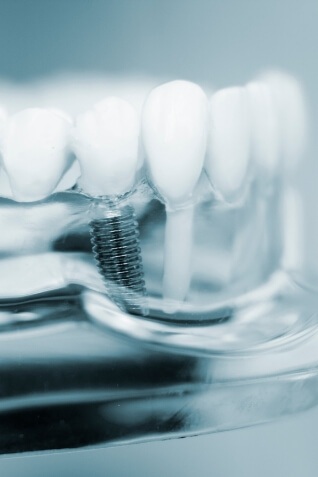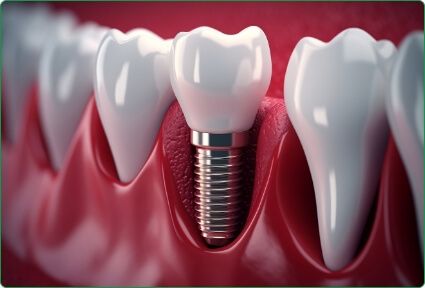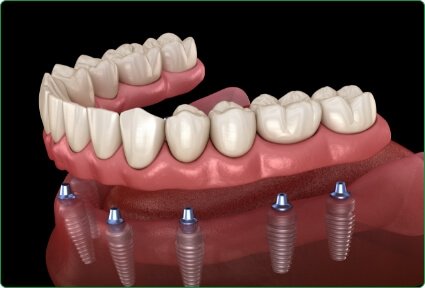Dental Implants Yarmouth
Completely Replacing Your Missing Teeth

One thing to note about traditional bridges and dentures is that they only replace the top parts of your missing teeth. Dental implants, on the other hand, can replace the entire tooth structure – including the roots. This is a major reason why dental implants have become more and more popular in recent years. Have you heard of the benefits of dental implants in Yarmouth and want to use them to fill in the space in your grin left by missing teeth? Step one is to give our team at Forest Falls Dental a call to schedule your initial consultation.
Why Choose Forest Falls Dental for Dental Implants?
- The Latest Dental Technology
- Practice That Puts Patients First
- Dental Team That You Can Trust
What Are Dental Implants?

A dental implant has three main parts: the post, the abutment, and the restoration. The post is shaped like a screw and is surgically placed in the jawbone. The abutment is a metal connector piece that can be attached to the post once your mouth has sufficiently healed. Eventually the restoration – which will be designed to closely resemble your natural teeth – will be attached to the implant post with the help of the abutment. Thanks to all of their components, dental implants are highly sturdy and stable, and they both look and feel lifelike.
The 4-Step Dental Implant Process

Before you start the dental implant process, you should make sure that you understand the steps involved. Note that the timeline can vary from patient to patient, but it will typically take months to put the finishing touches on your smile.
First, an initial consultation will be held. This will allow us to evaluate your oral health and make sure there aren’t any issues that could prevent you from having dental implants placed. Some preliminary procedures may need to be performed, after which the dental implant posts can be surgically inserted into your jaw. Once the procedure is complete, the implant posts will need about 3 to 6 months to fuse with the bone. An abutment will be attached to each post, and your final restoration will be designed based on an impression of your teeth. Once your final crown, bridge, or denture is ready, it can be anchored to your dental implant posts to complete your new grin.
Benefits of Dental Implants

Traditional dentures and bridges remain reliable tooth replacement options even to this day. However, there are certain benefits that you can only enjoy by replacing your missing teeth from the roots up with dental implants.
Here are some of the advantages that dental implants have to offer:
- Dental implants can help prevent the bone loss associated with missing teeth by providing the stimulation that would normally come from your tooth roots.
- Your new teeth will stay firmly in place and allow you to eat virtually anything you want.
- You will likely feel more confident thanks to having a complete smile that looks and feels lifelike.
- You can potentially save money in the long term since dental implants can last for decades before they have to be replaced.
- You can brush and floss dental implants as if they were real teeth.
Who Dental Implants Can Help

Our team will need to determine whether dental implants are truly a viable option for you. To be a good candidate, you will need to have a certain level of bone density in your jaw. On top of that, we’ll need to make sure you don’t have gum disease or any other dental issues that might interfere with your ability to have dental implants placed. Our team will take the time to discuss all of your options before helping you decide whether it’s worth moving forward with dental implant surgery.
Missing One Tooth

Have you lost just one tooth? All you need to fill in the gap is a dental implant post and a crown. We may suggest this as an alternative to having a traditional dental bridge placed so that you don’t need to worry about having any of your natural enamel removed.
Missing Multiple Teeth

When you have lost multiple teeth, it may not be necessary to get a dental implant post for each one. For example, in cases where three or more consecutive teeth have been lost, it may be possible to fill the space with two dental implants and a bridge.
Missing All of Your Teeth

When all of the teeth in your upper or lower jaw are missing, your first thought may be to get a traditional denture. However, you can also get an implant denture that won’t slip or shift in your mouth at inconvenient times. Implant dentures are typically supported by 4 to 6 dental implant posts.
Understanding the Cost of Dental Implants

If you’re thinking about getting dental implants, our team can give you an estimate of how much the procedure will cost. Said estimate will take a number of variables into account, including the exact number of implant posts needed. It should be noted that dental insurance typically doesn’t pay for dental implants, but it might still partially cover things like the final restoration; we can help you review your benefits as well as any other options that can make dental implants more affordable.
